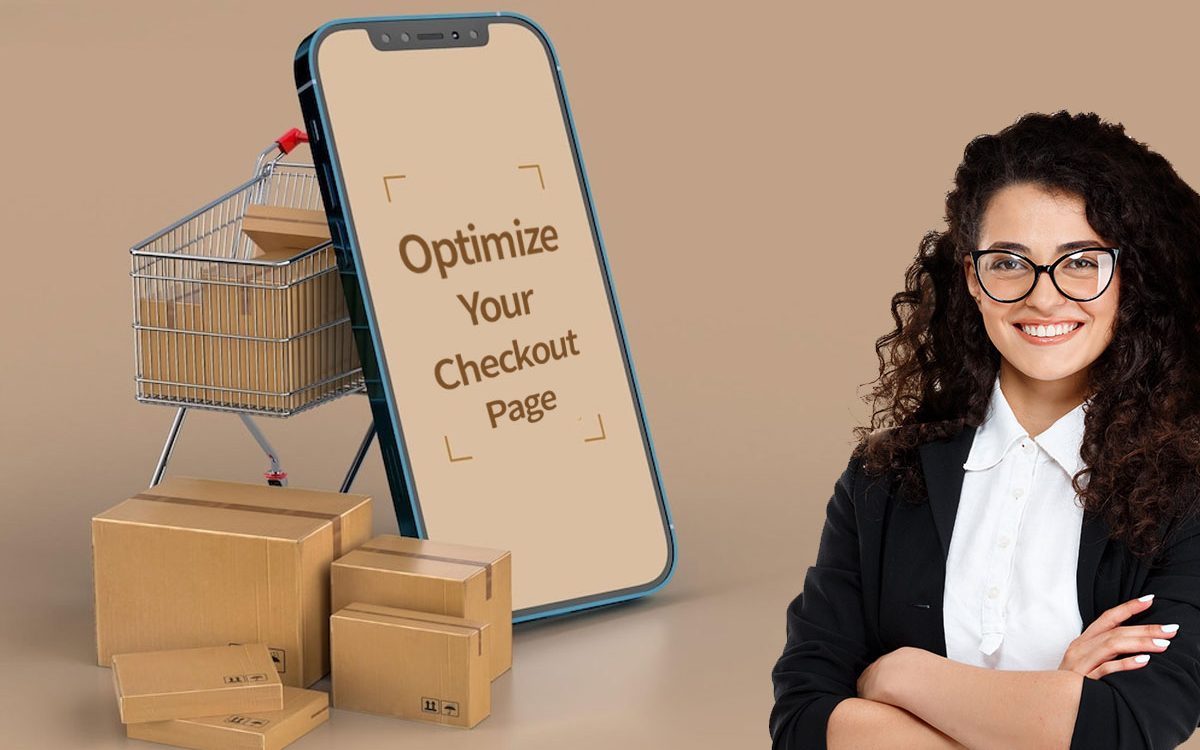
Subscribe to our Blogs
Stay on top of the latest digital marketing tips, trends & best practices.
FREE OF ANY CHARGES • NO CREDIT CARD REQUIRED
Date of Publication: 6 Sep 2022
It is a business’s goal to sell their products or services to customers. With uniqueness giving away to the ease of access, it is becoming increasingly critical to stand out by providing a smoother experience for customers. In today’s online stores, making the entire purchasing process comfortable for the consumer is more important than making unique goods and services.
In the ecommerce business, we often neglect to improve the payment processes in favor of improving the other aspects of the purchase process. Due to a complex payment system, your customers may abandon their cart as soon as they reach your checkout page.
To reduce cart abandonment, you should be thorough and creative with your checkout page design. Here are some tips to optimize your checkout page.

Digital Marketing Expert | Media Strategist | Entrepreneur

1. The length should be reduced
In addition to saving time and effort, customers prefer online shopping over physical retail shopping. They might be disinterested if they find that even online platforms involve lengthy procedures.
Keep your checkout page designs short and sweet as a merchant to mitigate this problem. Simply ask for the relevant information you need, such as an address, name, and payment method.
2. Provide multiple payment options
Lack of payment options leads to a large percentage of customers abandoning shopping carts. It is therefore necessary to offer multiple payment options in order to increase conversion rates.
Obviously, it won’t be possible to include every method of payment in the world, but by researching your target audience thoroughly, you will be able to find out which methods they prefer.
Of all the steps involved in online shopping, the checkout process is one of the most important for you and your customers. If potential customers cannot safely locate your checkout page, they may be hesitant to enter important transaction details and purchase your product or service.
Choose a checkout page design that looks safe and secure so your customers can build trust in your business. Includes his SSL certificates, security badges, and security verifications from various security platforms such as McAfee.
As a retailer, you may want to receive customer data for marketing campaigns. However, it is important to understand that not all customers are interested in promotions and promotions.
Therefore, it is better not to force the registration procedure. Eliminate the need for customers to set up accounts to purchase products.
A one-page checkout is always desirable, but it’s often difficult to fit all the details you need on one page. However, this can annoy users if they don’t know how long the payment process will take. Showing a progress bar lets them know how far the checkout process has progressed.
Firstly for sellers, a payment gateway is an online payment software that makes transactions easier. Furthermore, these gateways are integrated into eCommerce software to give them an edge in the market. Basically, a payment gateway is a software that provides an online payment service to eCommerce merchants to process e-purchases made by the customers. It reads the customer’s information and transfers it to the customer’s bank account. Therefore making sure that it captures correct data, the availability of sufficient funds to ensure the merchant gets paid.
In this method, the customer can use any mode of payment for their convenience. This includes credit cards, debit cards, wallets, UPI, or net banking. Which is further processed by the payment gateway software.
A payment gateway acts as an intermediary between the customer’s bank and the e-commerce merchant’s bank. All payment gateways involve the following key stakeholders in the process:
Step 1: The gateway works when a customer places an order online. He can pay cash on delivery (cash on delivery) or online. The process begins when the customer decides to pay online.
Step 2: The payment gateway starts checking whether the issuing bank has sufficient funds. Check if the transaction exceeds your credit limit or bank account balance.
Step 3: The payment gateway then encrypts the card information and securely transmits it to the card scheme to ensure the transaction is processed.
Step 4: Once the card scheme approves the transaction, the payment gateway sends it back to the merchant’s website. where the transaction is completed.
Step 5: The payment gateway then sends the information to the acquiring bank. Where a bank processes requests to transfer funds from a customer’s account to a merchant’s account.
Consumers are making more online purchases than ever, according to PWC’s 2019 Global Consumer Insights Survey. From 2010 to 2015, the percentage of consumers who shop online more than doubled, from 7% to 17%. Therefore, if you’ve been considering giving your website payment capabilities, this is the time to do it!
In the simplest terms, one of the most popular methods for accepting online payments is a hosted payment page, often known as an external checkout, third-party checkout, external payment page, or checkout page.
It is a third-party checkout web form that handles electronic transactions (payments made with credit and debit cards).
In exchange for a small transaction fee, these Hosted Checkout Pages will take care of the entire transaction process: payment information collection, sensitive data protection, and transaction security.

If you only use a Hosted Payment Page to process payments, your Payment Card Industry Data Security Standard (PCI DSS) requirements are usually lower. The entire process of PCI Compliance becomes as easy for you as filling out a Self-Assessment Questionnaire form.
Why is a Hosted Payment Page important?
Hosted Payment Pages can be useful whether you are accepting donations, selling goods online, or both. You as a merchant don’t have to be concerned about customers’ sensitive data because these solutions are hosted on secure third-party servers. The advantages of hosted payment pages are obvious: rapid setup, excellent data security, reduced PCI scope and expenses, enhanced checkout. The most crucial benefit is that you may concentrate on the business strategy and approaches to advance it while third-party Hosted Checkout Pages handle all the tedious payment procedures. If you only use a Hosted Payment Page to process payments, your Payment Card Industry Data Security Standard (PCI DSS) requirements are usually lower. The entire process of PCI Compliance becomes as easy for you as filling out a Self-Assessment Questionnaire form.
Every payment solution provider has its own terms of use and fees. Usually, you will have the following fee types:
Read all the pricing documentation to avoid hidden fees or additional expenses
While fees and installation charges are inevitable, there is one thing that may determine whether you can work with a certain provider. Gateway providers set transaction limits as a minimum and maximum amount. Both values are of interest to merchants and their businesses, as you want to use a single gateway for all the available products. The second thing you should pay attention to is daily or monthly transaction limits. These occur pretty rarely, but also play a huge role in gateway provider choice.
A merchant account is an agreement between a merchant and an acquiring bank, by which a merchant allows a bank to process their transactions. Additionally, a merchant agrees to follow the operational regulations of credit card processing established by credit card companies.
A merchant account can be opened through banks or payment gateway providers, that offer merchant accounts as a part of a service.
Credit cards is a major payment method, you have to make sure a payment gateway accepts all the required credit card networks. Also check whether you can accept other modes of payments like UPI, Paypal, Rupay, PhonePe, Apple Pay, Gpay, Samsung Pay etc.Another aspect is multi-currency support. If your business is international, you want your customers to be able to pay, no matter what currency they use. Popular gateway providers offer multi-currency support processing with or without an additional fee.
Generally, there are two types of products considered by providers: digital and physical. Some of the payment solution providers offer their services both for physical and digital products. But it’s not rare for only one type of product to be available in use of a certain system. So, before subscribing to a provider, make sure it permits your type of a product.
Payments are usually approved almost immediately, but funds are held for several days before being credited to your account. This is for processing refunds and chargebacks. These hold periods vary from 1 to 7 days depending on the payment service provider. Depending on your cash flow, you can choose to wait or get paid immediately.
When you receive payments online, the security of your payment gateway should be your top priority as you store sensitive financial information. Keep in mind that different payment gateways comply with different security standards, so make sure the gateway you choose is Level 1 PCI DSS compliant. Some gateways are equipped with fraud detection and other screening tools to protect your business from fraudulent transactions.
The majority of customers today shop on mobile phones and tablets, so it’s important to choose a gateway that also accepts payments from mobile devices. This gives your customers the flexibility to pay regardless of the device they use.
Some payment gateways cap the amount of transactions they can process per month. This is not a problem for small businesses. However, if your business deals in high-value items or processes a high volume of transactions, you may lose potential customers, so you should be aware of these limitations.
Finally, it’s worth considering whether your payment gateway can connect to your billing or accounting software. This will automatically update the relevant invoices in your accounting system when you pay online. This saves a lot of time and effort as you don’t have to track payments and manually update that payment information in your accounting system.
If you operate internationally, you need to ensure that your payment gateway can process payments in different currencies and from different countries. Most importantly, customers can pay in their own currency. You should also look for fees associated with foreign currency transactions.
If you run a subscription-based business, you should choose a payment gateway that can handle all the variable parts of your recurring bills. Your provider of choice should be able to save and store customer details for future transactions, automatically charge credit cards according to pre-set subscription schedules, and offer retry options for failed transactions. I have. Otherwise, you may have to do this extra work manually.
One-click on checkout or unmarried price is a comfort characteristic that lets in a service provider to pay for items and offerings together along with her unmarried click on of a button. However, those clients can be required to go into their card info in the course of their first transaction with a selected retailer, and a unmarried price choice can be to be had for next purchases from the identical retailer. Accepted payments: credit score cards, debit cards, e-wallets (relying on solution).
After coming into all price info (card number, CVV, expiration date, cardholder first and ultimate name, etc.), the consumer makes his first buy at the service provider`s internet site.This preliminary transaction is tokenized and all statistics is saved withinside the device.When the identical consumer returns to the identical retailer’s internet site to save again, the device acknowledges them as repeat clients.A one-click on price choice is to be had and shoppers select to pay with it.The device makes use of pre-saved statistics to technique the transaction and price the cardholder. (This technique may also fluctuate for different price methods).
Creating a custom payment gateway requires several steps:
You may also use open-source payment gateway solutions. It is possible to use an open-source payment gateway (like OmniPay, PayU, Active Merchant) software that will lower the costs of the engineering. But it will, again, restrict you in customization options.
If you have found this blog helpful please like & share
We hope the article helped you understand the topic, but you might still have questions about how it can work for your business / brand. At Tejom Digital, we have built a reputation for answering those tricky questions.
Are you looking to take your business to the next level?
Tejom Digital
is here to help!
Our award-winning digital marketing agency has the expertise and data-driven solutions to ensure optimal reach, engagement, traffic and conversion. With our proven strategies, you can rest assured that your business will be seen by the right people and achieve your desired outcomes. Plus, we offer comprehensive and personalized packages tailored to your specific needs! Let us help you reach your goals today.
FREE OF ANY CHARGES • NO CREDIT CARD REQUIRED





